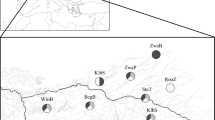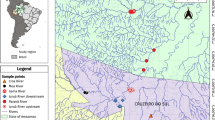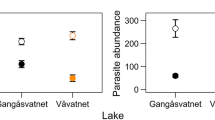Abstract
Parasite communities have been shown to be structured by processes at scales ranging from continental to microhabitat, but few studies have simultaneously considered spatial and environmental variables, measured at different scales, to assess their relative influences on parasite abundance, species richness, and community similarity. Parasite abundance, diversity, and community similarity in Athabasca River trout-perch (Percopsis omiscomaycus) were examined in relation to water quality, substrate profile, metal and organic compound levels in water and sediment, and landscape use patterns at different scales, as well as distance among sites and upstream-downstream position along the river. Although species richness did not differ among sites, there were significant differences in abundance of individual taxa and community structure. We observed a shift from communities dominated by larval trematodes Diplostomum spp. to domination by gill monogeneans Urocleidus baldwini, followed by a reversion further downstream. Variations in the abundance of these taxa and of overall community similarity were strongly correlated with sediment hydrocarbons (alkanes and polycyclic aromatic hydrocarbons (PAHs)) as well as landscape use within 5 km of study sites. No correlations were noted with any other predictors, indicating that parasite populations and communities in this system were likely primarily influenced by habitat level and landscape-scale filters, rather than larger-scale processes such as distance decay or river continuum effects.





Similar content being viewed by others
References
Anderson MJ (2001) A new method for non-parametric multivariate analysis of variance. Austral Ecol 26:32–46
Anderson TK, Sukhdeo MVK (2009) Abiotic versus biotic hierarchies in the assembly of parasite populations. Parasitology 137:743–754
Baldwin RE, Goater CP (2003) Circulation of parasites among fishes from lakes in the Caribou Mountains, Alberta, Canada. J Parasitol 89:215–225
Beverley-Burton M (1984) Monogenea and Turbellaria. In: Margolis L and Kabata Z (eds) Guide to the parasites of fishes of Canada. Part I. Canadian Special Publication of Fisheries and Aquatic Sciences 74, pp 5–209
Bidleman TF (1999) Atmospheric transport and air-surface exchange of pesticides. Water Air Soil Pollut 115:115–166
Blanar CA, Munkittrick KR, Houlahan J, MacLatchy DL, Marcogliese DJ (2009) Pollution and parasitism in aquatic animals: a meta-analysis of effect size. Aquat Toxicol 93:18–28
Blanar CA, MacLatchy DL, Kieffer JD, Munkittrick KR (2010) Exposure to a mixture of zinc and copper decreases survival and fecundity of Discocotyle sagittata (Leuckart) parasitizing juvenile Atlantic salmon, Salmo salar L. Bull Environ Contam Toxicol 84:692–697
Blanar CA, Marcogliese DJ, Couillard CM (2011) Natural and anthropogenic factors shape metazoan parasite community structure in mummichog (Fundulus heteroclitus) from two estuaries in New Brunswick, Canada. Folia Parasitol 58:240–250
Blasco-Costa I, Koehler AV, Martin A, Poulin R (2013) Upstream-downstream gradient in infection levels by fish parasites: a common river pattern? Parasitology 140:266–274
Bush AO, Lafferty KD, Lotz JM, Shostak AW (1997) Parasitology meets ecology on its own terms: Margolis et al. revisited. J Parasitol 83:575–583
Clarke KR, Gorley RN (2006) PRIMER v6: user manual/tutorial. PRIMER-E, Plymouth
Clarke KR, Gorley RN, Somerfeld PJ, Warwick RM (2014) Change in marine communities: an approach to statistical analysis and interpretation, 3rd edn. PRIMER-E, Plymouth
Coggins JR, Tedesco JL, Rupprecht CE (1982) Seasonal changes and overwintering of parasites in the bat, Myotis lucifugus (Le Conte), in a Wisconsin hibernaculum. Am Midl Nat 107:305–315
Conly FM, Crosley RW, Headley JV (2002) Characterizing sediment sources and natural hydrocarbon inputs in the lower Athabasca River, Canada. J Environ Eng Sci 1:187–199
Dautremepuits C, Marcogliese DJ, Gendron AD, Fournier M (2008) Gill and head kidney antioxidant processed and innate immune system responses of yellow perch (Perca flavescens) exposed to different contaminants in the St. Lawrence River, Canada. Sci Total Environ 407:1055–1064
Dechtiar AO (1974) Cleidodiscus baldwini vi. sp. (Monogenoidea: Ancyrocephalinae) from the gills of trout-perch (Percopsis omiscomaycus) of Lake Huron. J Fish Res Board Can 31:163–165
Désilets HD, Locke SA, McLaughlin JD, Marcogliese DJ (2013) Community structure of Diplostomum spp. (Digenea: Diplostomidae) in eyes of fish: main determinants and potential interspecific interactions. Int J Parasitol 43:929–939
Diamant A, Banet A, Paperna I, Westernhagen HV, Broeg K, Kruener G, Koerting W, Zander S (1999) The use of fish metabolic, pathological and parasitological indices in pollution monitoring. II. The Red Sea and Mediterranean. Helgol Mar Res 53:195–208
Fausch KD, Togersen CE, Baxter CV, Li HW (2002) Landscapes to riverscapes: bridging the gap between research and conservation of stream fishes. Bioscience 52:483–498
Fenton MM, Waters EJ, Pawley SM, Atkinson N, Utting DJ, McKay K (2013) Alberta Geological Survey: surficial geology of Alberta (http://www.ags.gov.ab.ca/publications/abstracts/Map_601.html, accessed October 27, 2014)
Gibbons WN, Munkittrick KR, McMaster ME, Taylor WR (1998) Monitoring aquatic environments receiving industrial effluents using small fish species. 2. Comparison between responses of trout-perch (Percopsis omiscomaycus) and white sucker (Catostomus commersoni) downstream of a pulp mill. Environ Toxicol Chem 17:2238–2245
Gibson DI (1996) Trematoda. In: Margolis L, Kabata Z (eds) Guide to the parasites of fishes of Canada. Part IV. Can Spec Pub Fish Aquatic Sci 124: 1–373
Guégan JF, Morand S, Poulin R (2005) Are there general laws in parasite community ecology? The emergence of spatial parasitology and epidemiology. In: Thomas F, Renaud JF, Guégan JF (eds) Parasitism and ecosystems. Oxford Biology, Oxford
Hatfield Consultants (2009). RAMP technical design and rationale. RAMP1467.1. Retrieved from http://www.ramp-alberta.org/UserFiles/File/RAMP_Design_&_Rationale.pdf
Headley JV, Akre C, Conly FM, Peru KM, Dickson LC (2001) Preliminary characterization and source assessment of PAHs in tributary sediments of the Athabasca River, Canada. Environ Forensic 2:335–345
Hechinger RF, Lafferty KD (2005) Host diversity begets parasite diversity: bird final hosts and trematodes in snail intermediate hosts. Proc Nat Soc Lond B 272:1059–1066
Hoffman GL (1999) Parasites of North American freshwater fishes, 2nd edn. Cornell University Press, Ithaca
Holt RD (1999) A biogeographical and landscape perspective on within-host infection dynamics. In: Bell CR, Brylinsky M, Joshnson-Green P (eds) Microbial biosystems: new frontiers. Proceedings of the 8th International Symposium on Microbial Ecology. Canada Society for Microbial Ecology, Halifax
Kelly EN, Short JW, Schindler DW, Hodson PV, Ma M, Kwan AK, Fortin BL (2009) Oil sands development contributes polycyclic aromatic compounds to the Athabasca River and its tributaries. Proc Natl Acad Sci U S A 106:22346–22351
Khan RA, Thulin J (1991) Influence of pollution on parasites of aquatic animals. Adv Parasitol 30:201–238
King KC, McLaughlin JD, Boily M, Marcogliese DJ (2010) Effects of agricultural landscape and pesticides on parasitism in native bullfrogs. Biol Conserv 143:302–310
Krasnov BR, Shenbrot GI, Kholkhova IS, Stanko M, Morand S, Mouillot D (2014) Assembly rules of ectoparasite communities across scales: combining patterns of abiotic factors, host composition, geographic space, phylogeny and traits. Ecography 37:001–014
Kuchta R, Vlčková R, Poddubnaya LG, Gustinelli A, Dzika E, Scholz T (2007) Invalidity of three Palearctic species of Triaenophorus tapeworms (Cestoda: Pseudophyllidea): evidence from morphometric analysis of scolex hooks. Folia Parasitol 54:34–42
Lafferty KD (1997) Environmental parasitology: what can parasites tell us about human impacts on the environment? Parasitol Today 13:251–255
Landsberg JH, Blakesley BA, Reese RO, McRae G, Forstchen PR (1998) Parasites of fish as indicators of environmental stress. Environ Monit Assess 51:211–232
Lenat DR, Penrose DL (1996) History of the EPT taxa richness metric. Bull N Am Benthol Soc 13:305–306
Locke SA, McLaughlin JD, Dayanandan S, Marcogliese DJ (2010) Diversity, specificity and evidence of hybridization in Diplostomum spp. metacercariae in freshwater fishes is revealed by DNA barcodes and ITS sequences. Int J Parasitol 40:333–343
Locke SA, Levy MS, Marcogliese DJ, Ackerman S, McLaughlin JD (2012) The decay of parasite community similarity in ring‐billed gulls Larus delawarensis and other hosts. Ecography 35:530–538
Locke SA, McLaughlin JD, Marcogliese DJ (2013) Predicting the similarity of parasite communities in freshwater fishes using the phylogeny, ecology and proximity of hosts. Oikos 122:73–83
MacKenzie K (1999) Parasites as pollution indicators in marine ecosystems: a proposed early warning system. Mar Pollut Bull 38:955–959
MacKenzie K, Williams HH, Williams B, McVicar AH, Siddall R (1995) Parasites as indicators of water quality and the potential use of helminth transmission in marine pollution studies. Adv Parasitol 35:85–144
Marcogliese DJ (2005) Parasites of the superorganism: are they indicators of ecosystem health? Int J Parasitol 35:705–716
Marcogliese DJ, Compagna S, Bergeron E, McLaughlin JD (2001) Population biology of eyeflukes in fish from a large fluvial ecosystem: the importance of gulls and habitat characteristics. Can J Zool 79:1102–1113
Marcogliese DJ, Gendron AD, Plante C, Fournier M, Cyr D (2006) Parasites of spottail shiners (Notropis hudsonius) in the St. Lawrence River: effects of municipal effluents and habitat. Can J Zool 84:1461–1481
Marcogliese DJ, Gendron AD, Cone DK (2009) Impact of municipal effluents and hydrological regime on myxozoan parasite communities of fish. Int J Parasitol 39:1345–1351
Margolis L, Arthur JR (1979) Synopsis of the parasites of fishes of Canada. Bull Fish Res Board Can 179:1–269
McDonald TE, Margolis L (1995) Synopsis of the parasites of fishes of Canada: supplement (1978–1993). Can Spec Publ Fish Aquat Sci 122:1–265
Moravec F (1994) Parasitic nematodes of freshwater fishes of Europe. Kluwer Academic Publishers, Dordrecht
Nelson PA, Dick TA (2002) Factors shaping the parasite communities of trout-perch, Percopsis omiscomaycus Walbaum (Osteichthyes: Percopsidae), and the importance of scale. Can J Zool 80:1986–1999
Nelson PA, Choudhury A, Dick TA (1997) Crepidostomum percopsisi n. sp. (Digenea: Allocreadidae) from the trout perch (Percopsis omiscomaycus) of Dauphin Lake, Canada. J Parasitol 83:1157–1160
Nelson PA, Johnson MW, Cott PA (2010) Parasites and diet of trout-perch (Percopsis omiscomaycus) from Northwest Territories, Canada, with comments on the range of Crepidostomum percopsisi Nelson, Chudhury and Dick 1997. Comp Parasitol 77:94–99
NLET (2008) SOP 2003—standard operating procedure for the analysis of dissolved, extractable and total trace metals by “direct aspiration” or “in bottle digestion” using inductively coupled plasma-sector field mass spectrometry (ICP-SFMS). Environment Canada, Burlington
Petts GE (2009) Rivers: dynamic components of catchment ecosystems. In: Calow PP, Petts GE (eds) Rivers handbook: the science and management of river environments. Blackwell Science Ltd, Oxford
Poff NL (1997) Landscape filters and species traits: towards mechanistic understanding and prediction in stream ecology. J North Am Benthol Soc 16:391–409
Poulin R (1992) Toxic pollution and parasitism in freshwater fish. Parasitol Today 8:58–61
Poulin R (2001) Interactions between species and the structure of helminth communities. Parasitology 122(S1):S3–S11
Poulin R (2003) The decay of similarity with geographical distance in parasite communities of vertebrate hosts. J Biogeogr 30:1609–1615
Poulin R, Morand S (1999) Geographical distance and the similarity among parasite communities of conspecific host populations. Parasitology 119:369–374
Poulin R, Blanar CA, Thieltges D, Marcogliese DJ (2011) The biogeography of parasitism in sticklebacks: distance, habitat differences and the similarity in parasite occurrence and abundance. Ecography 34:540–551
Reiczigel J (2003) Confidence intervals for the binomial parameter: some new considerations. Stat Med 22:611–621
Rózsa L, Reiczigel J, Majoros G (2000) Quantifying parasites in samples of hosts. J Parasitol 86:228–232
Schindler DW (2010) Tar sands need solid science. Nature 468:499–501
Schmidt GD (1986) Handbook of tapeworm identification. CRC Press, Boca Raton
Scott WB, Crossman EJ (1973) Freshwater fishes of Canada. Bulletin 184. Fisheries Research Board of Canada, Ottawa
Thieltges DW, Dolch T, Krakau M, Poulin R (2010) Salinity gradient shapes distance decay of similarity among parasite communities in three marine fishes. J Fish Biol 76:1806–1814
Vannote RL, Minshall GW, Cummins KW, Sedell JR, Cushing CE (1980) The river continuum concept. Can J Fish Aquat Sci 37:130–137
Vidal-Martinez VM, Pech D, Sures B, Purucker ST, Poulin R (2010) Can parasites really reveal environmental impact? Trends Parasitol 26:44–51
Wang Z, Yang C, Parrott JL, Frank RA, Yang Y, Brown CE, Hollebone BP, Landriault M, Fieldhouse B, Liu Y, Zhang G, Hewitt LM (2014) Forensic source differentiation of pterogenic, pyrogenic, and biogenic hydrocarbons in Canadian oil sands environmental samples. J Hazard Mater 271:166–177
Warburton EM, Kohler SL, Vonhof MJ (2015) Patterns of parasite community dissimilarity: the significant role of land use and lack of distance-decay in a bat helminth system. Oikos. doi:10.1111/oik.02313
Acknowledgments
We thank François Boudreault for GIS data; Sean Locke for larval digenean identifications; František Moravec for advice on nematode identification; Andrée Gendron and members of the Marcogliese lab for technical assistance; Gerald Tetreault, Jim Bennett, Thomas Clark, Heather Keith, D. Gilroy, R. Neureuther, R. Frank, and C. Talbot for assistance with field collections; and R. Vanderveen, S. Batchelor, and M. Brown for sample distributions to participating laboratories. We are also grateful to Yves de Lafontaine and several anonymous reviewers for their constructive comments.
Author information
Authors and Affiliations
Corresponding author
Ethics declarations
Financial support
CAB was supported by a Natural Sciences and Engineering Research Council Visiting Fellowship in a Canadian Government Laboratory. This project was supported by Environment Canada.
Ethical approval
All applicable international, national, and/or institutional guidelines for the care and use of animals were followed.
Electronic supplementary material
Below is the link to the electronic supplementary material.
ESM 1
(DOCX 14 kb)
Rights and permissions
About this article
Cite this article
Blanar, C.A., Hewitt, M., McMaster, M. et al. Parasite community similarity in Athabasca River trout-perch (Percopsis omiscomaycus) varies with local-scale land use and sediment hydrocarbons, but not distance or linear gradients. Parasitol Res 115, 3853–3866 (2016). https://doi.org/10.1007/s00436-016-5151-x
Received:
Accepted:
Published:
Issue Date:
DOI: https://doi.org/10.1007/s00436-016-5151-x




